Industrialization Effects and Hindrances in Third World Countries
VerifiedAdded on 2023/04/25
|9
|2174
|178
Report
AI Summary
This report delves into the multifaceted effects of industrialization in third-world countries, examining its impact on economic growth, social structures, and environmental sustainability. It highlights the transformation from agrarian societies to industrial economies, focusing on both positive and negative consequences. The report explores job creation, increased investment, and reduced crime rates while also addressing the widening gap between rich and poor, health issues stemming from pollution, and challenges such as corruption and inadequate resource management. It references various studies to support its findings and concludes by emphasizing the importance of addressing the hindering factors to maximize the benefits of industrialization. The study covers topics such as the impact of industrialization on employment, poverty, and investment, as well as the role of corruption and government policies in hindering industrial progress. It also explores the effects of urbanization and industrialization on energy consumption and CO2 emissions. The report references several academic sources, including studies on economic growth in Africa, industrialization in Latin America and East Asia, and the impacts of urbanization and industrialization on energy consumption and emissions. The report aims to provide a comprehensive overview of the impacts of industrialization on third-world countries and the factors that either promote or hinder its success.
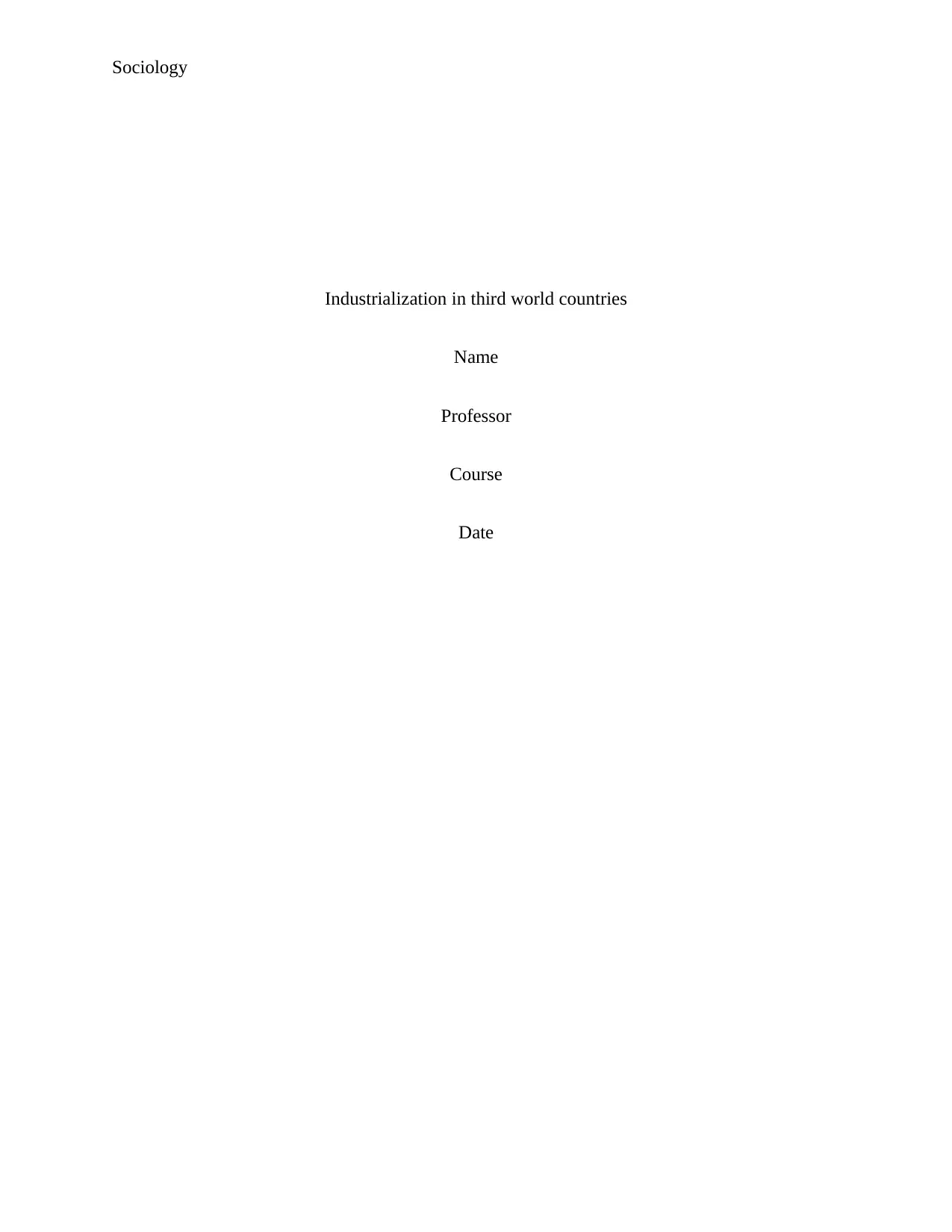
Sociology
Industrialization in third world countries
Name
Professor
Course
Date
Industrialization in third world countries
Name
Professor
Course
Date
Paraphrase This Document
Need a fresh take? Get an instant paraphrase of this document with our AI Paraphraser
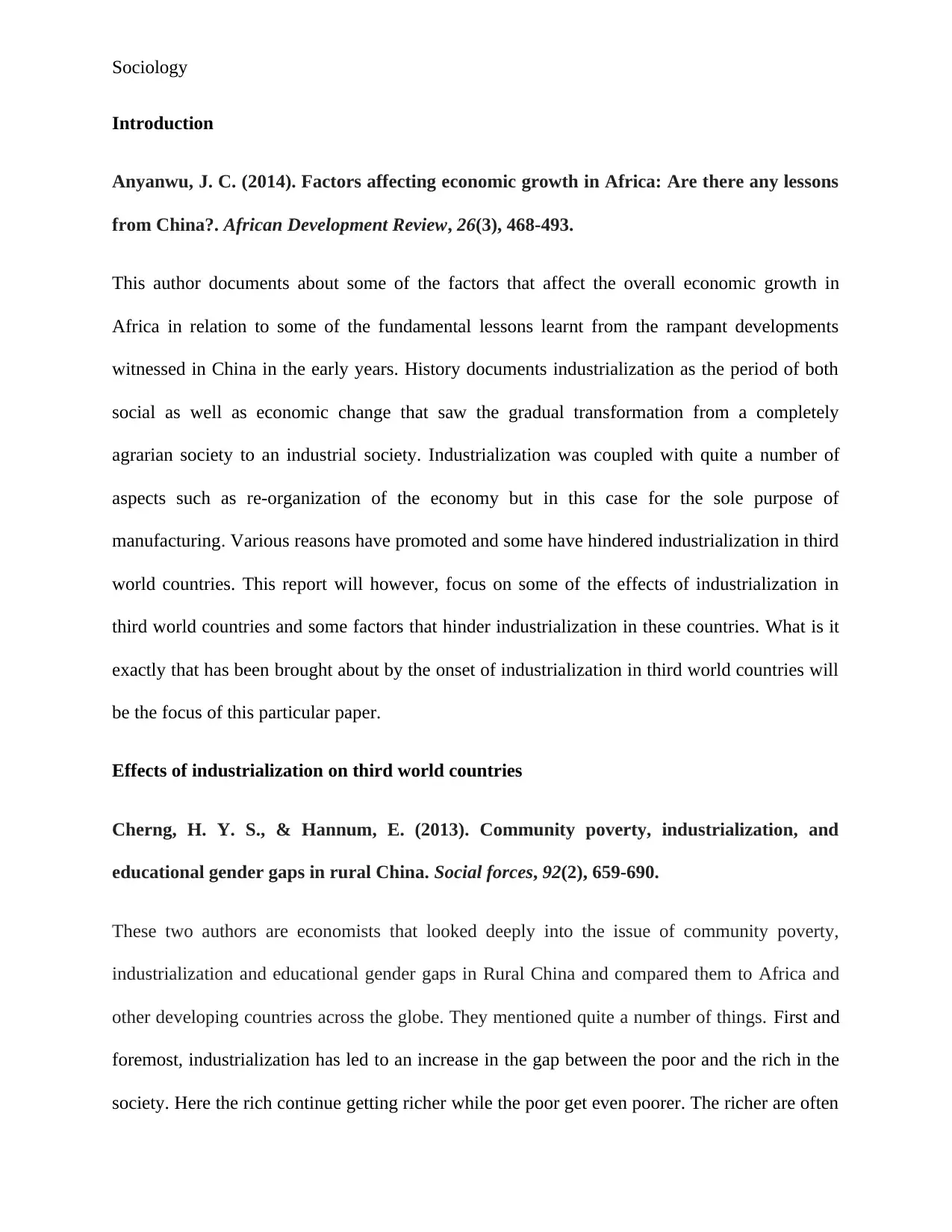
Sociology
Introduction
Anyanwu, J. C. (2014). Factors affecting economic growth in Africa: Are there any lessons
from China?. African Development Review, 26(3), 468-493.
This author documents about some of the factors that affect the overall economic growth in
Africa in relation to some of the fundamental lessons learnt from the rampant developments
witnessed in China in the early years. History documents industrialization as the period of both
social as well as economic change that saw the gradual transformation from a completely
agrarian society to an industrial society. Industrialization was coupled with quite a number of
aspects such as re-organization of the economy but in this case for the sole purpose of
manufacturing. Various reasons have promoted and some have hindered industrialization in third
world countries. This report will however, focus on some of the effects of industrialization in
third world countries and some factors that hinder industrialization in these countries. What is it
exactly that has been brought about by the onset of industrialization in third world countries will
be the focus of this particular paper.
Effects of industrialization on third world countries
Cherng, H. Y. S., & Hannum, E. (2013). Community poverty, industrialization, and
educational gender gaps in rural China. Social forces, 92(2), 659-690.
These two authors are economists that looked deeply into the issue of community poverty,
industrialization and educational gender gaps in Rural China and compared them to Africa and
other developing countries across the globe. They mentioned quite a number of things. First and
foremost, industrialization has led to an increase in the gap between the poor and the rich in the
society. Here the rich continue getting richer while the poor get even poorer. The richer are often
Introduction
Anyanwu, J. C. (2014). Factors affecting economic growth in Africa: Are there any lessons
from China?. African Development Review, 26(3), 468-493.
This author documents about some of the factors that affect the overall economic growth in
Africa in relation to some of the fundamental lessons learnt from the rampant developments
witnessed in China in the early years. History documents industrialization as the period of both
social as well as economic change that saw the gradual transformation from a completely
agrarian society to an industrial society. Industrialization was coupled with quite a number of
aspects such as re-organization of the economy but in this case for the sole purpose of
manufacturing. Various reasons have promoted and some have hindered industrialization in third
world countries. This report will however, focus on some of the effects of industrialization in
third world countries and some factors that hinder industrialization in these countries. What is it
exactly that has been brought about by the onset of industrialization in third world countries will
be the focus of this particular paper.
Effects of industrialization on third world countries
Cherng, H. Y. S., & Hannum, E. (2013). Community poverty, industrialization, and
educational gender gaps in rural China. Social forces, 92(2), 659-690.
These two authors are economists that looked deeply into the issue of community poverty,
industrialization and educational gender gaps in Rural China and compared them to Africa and
other developing countries across the globe. They mentioned quite a number of things. First and
foremost, industrialization has led to an increase in the gap between the poor and the rich in the
society. Here the rich continue getting richer while the poor get even poorer. The richer are often
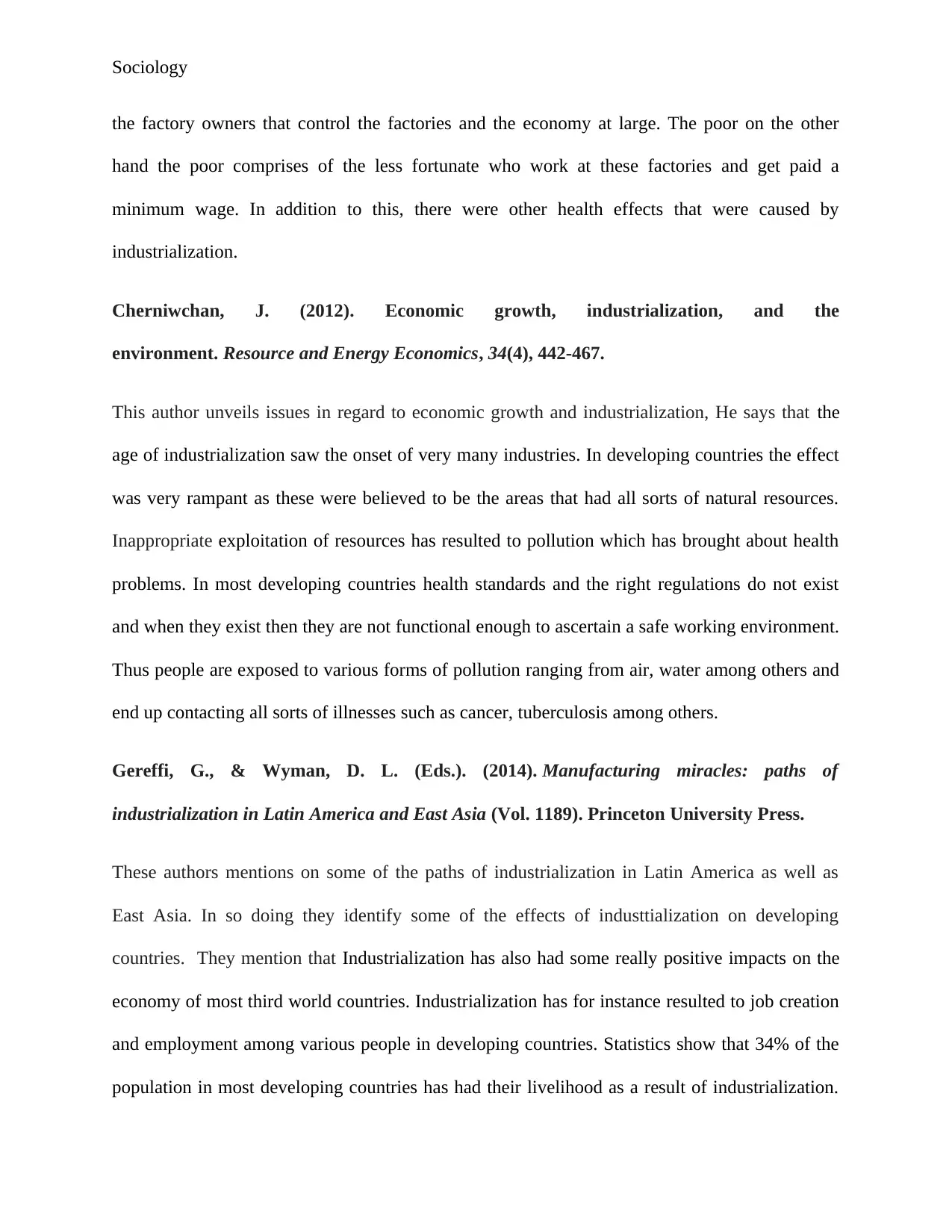
Sociology
the factory owners that control the factories and the economy at large. The poor on the other
hand the poor comprises of the less fortunate who work at these factories and get paid a
minimum wage. In addition to this, there were other health effects that were caused by
industrialization.
Cherniwchan, J. (2012). Economic growth, industrialization, and the
environment. Resource and Energy Economics, 34(4), 442-467.
This author unveils issues in regard to economic growth and industrialization, He says that the
age of industrialization saw the onset of very many industries. In developing countries the effect
was very rampant as these were believed to be the areas that had all sorts of natural resources.
Inappropriate exploitation of resources has resulted to pollution which has brought about health
problems. In most developing countries health standards and the right regulations do not exist
and when they exist then they are not functional enough to ascertain a safe working environment.
Thus people are exposed to various forms of pollution ranging from air, water among others and
end up contacting all sorts of illnesses such as cancer, tuberculosis among others.
Gereffi, G., & Wyman, D. L. (Eds.). (2014). Manufacturing miracles: paths of
industrialization in Latin America and East Asia (Vol. 1189). Princeton University Press.
These authors mentions on some of the paths of industrialization in Latin America as well as
East Asia. In so doing they identify some of the effects of industtialization on developing
countries. They mention that Industrialization has also had some really positive impacts on the
economy of most third world countries. Industrialization has for instance resulted to job creation
and employment among various people in developing countries. Statistics show that 34% of the
population in most developing countries has had their livelihood as a result of industrialization.
the factory owners that control the factories and the economy at large. The poor on the other
hand the poor comprises of the less fortunate who work at these factories and get paid a
minimum wage. In addition to this, there were other health effects that were caused by
industrialization.
Cherniwchan, J. (2012). Economic growth, industrialization, and the
environment. Resource and Energy Economics, 34(4), 442-467.
This author unveils issues in regard to economic growth and industrialization, He says that the
age of industrialization saw the onset of very many industries. In developing countries the effect
was very rampant as these were believed to be the areas that had all sorts of natural resources.
Inappropriate exploitation of resources has resulted to pollution which has brought about health
problems. In most developing countries health standards and the right regulations do not exist
and when they exist then they are not functional enough to ascertain a safe working environment.
Thus people are exposed to various forms of pollution ranging from air, water among others and
end up contacting all sorts of illnesses such as cancer, tuberculosis among others.
Gereffi, G., & Wyman, D. L. (Eds.). (2014). Manufacturing miracles: paths of
industrialization in Latin America and East Asia (Vol. 1189). Princeton University Press.
These authors mentions on some of the paths of industrialization in Latin America as well as
East Asia. In so doing they identify some of the effects of industtialization on developing
countries. They mention that Industrialization has also had some really positive impacts on the
economy of most third world countries. Industrialization has for instance resulted to job creation
and employment among various people in developing countries. Statistics show that 34% of the
population in most developing countries has had their livelihood as a result of industrialization.
⊘ This is a preview!⊘
Do you want full access?
Subscribe today to unlock all pages.

Trusted by 1+ million students worldwide
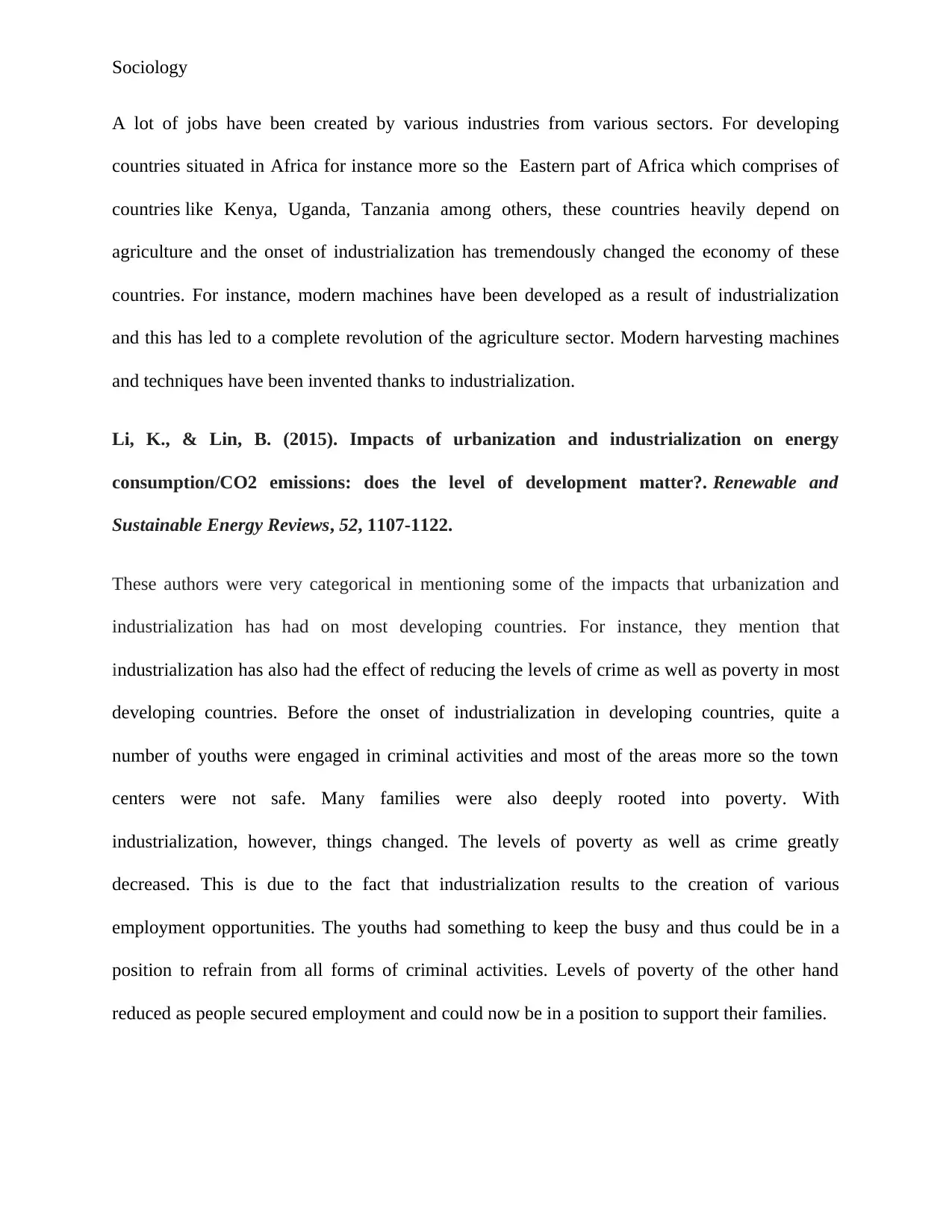
Sociology
A lot of jobs have been created by various industries from various sectors. For developing
countries situated in Africa for instance more so the Eastern part of Africa which comprises of
countries like Kenya, Uganda, Tanzania among others, these countries heavily depend on
agriculture and the onset of industrialization has tremendously changed the economy of these
countries. For instance, modern machines have been developed as a result of industrialization
and this has led to a complete revolution of the agriculture sector. Modern harvesting machines
and techniques have been invented thanks to industrialization.
Li, K., & Lin, B. (2015). Impacts of urbanization and industrialization on energy
consumption/CO2 emissions: does the level of development matter?. Renewable and
Sustainable Energy Reviews, 52, 1107-1122.
These authors were very categorical in mentioning some of the impacts that urbanization and
industrialization has had on most developing countries. For instance, they mention that
industrialization has also had the effect of reducing the levels of crime as well as poverty in most
developing countries. Before the onset of industrialization in developing countries, quite a
number of youths were engaged in criminal activities and most of the areas more so the town
centers were not safe. Many families were also deeply rooted into poverty. With
industrialization, however, things changed. The levels of poverty as well as crime greatly
decreased. This is due to the fact that industrialization results to the creation of various
employment opportunities. The youths had something to keep the busy and thus could be in a
position to refrain from all forms of criminal activities. Levels of poverty of the other hand
reduced as people secured employment and could now be in a position to support their families.
A lot of jobs have been created by various industries from various sectors. For developing
countries situated in Africa for instance more so the Eastern part of Africa which comprises of
countries like Kenya, Uganda, Tanzania among others, these countries heavily depend on
agriculture and the onset of industrialization has tremendously changed the economy of these
countries. For instance, modern machines have been developed as a result of industrialization
and this has led to a complete revolution of the agriculture sector. Modern harvesting machines
and techniques have been invented thanks to industrialization.
Li, K., & Lin, B. (2015). Impacts of urbanization and industrialization on energy
consumption/CO2 emissions: does the level of development matter?. Renewable and
Sustainable Energy Reviews, 52, 1107-1122.
These authors were very categorical in mentioning some of the impacts that urbanization and
industrialization has had on most developing countries. For instance, they mention that
industrialization has also had the effect of reducing the levels of crime as well as poverty in most
developing countries. Before the onset of industrialization in developing countries, quite a
number of youths were engaged in criminal activities and most of the areas more so the town
centers were not safe. Many families were also deeply rooted into poverty. With
industrialization, however, things changed. The levels of poverty as well as crime greatly
decreased. This is due to the fact that industrialization results to the creation of various
employment opportunities. The youths had something to keep the busy and thus could be in a
position to refrain from all forms of criminal activities. Levels of poverty of the other hand
reduced as people secured employment and could now be in a position to support their families.
Paraphrase This Document
Need a fresh take? Get an instant paraphrase of this document with our AI Paraphraser
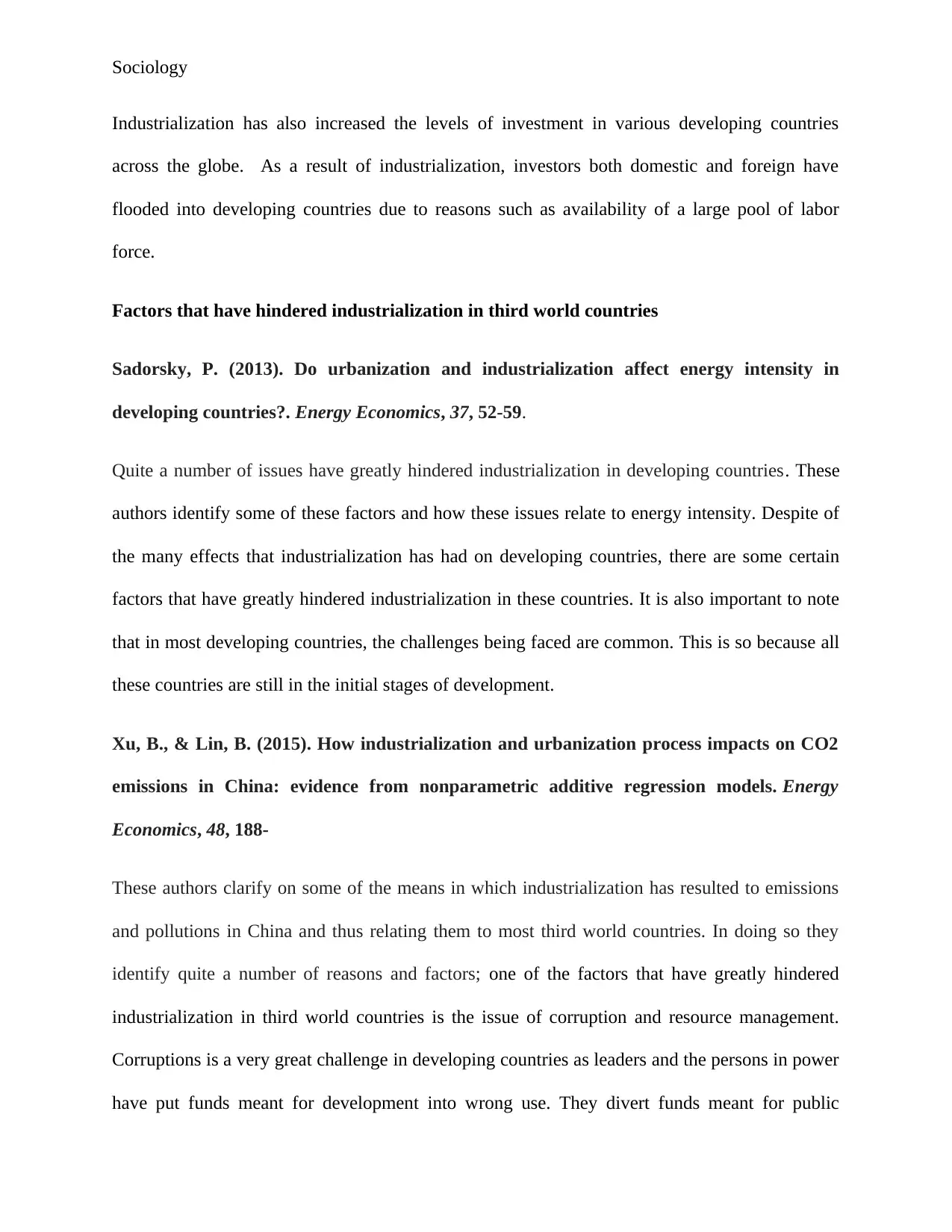
Sociology
Industrialization has also increased the levels of investment in various developing countries
across the globe. As a result of industrialization, investors both domestic and foreign have
flooded into developing countries due to reasons such as availability of a large pool of labor
force.
Factors that have hindered industrialization in third world countries
Sadorsky, P. (2013). Do urbanization and industrialization affect energy intensity in
developing countries?. Energy Economics, 37, 52-59.
Quite a number of issues have greatly hindered industrialization in developing countries. These
authors identify some of these factors and how these issues relate to energy intensity. Despite of
the many effects that industrialization has had on developing countries, there are some certain
factors that have greatly hindered industrialization in these countries. It is also important to note
that in most developing countries, the challenges being faced are common. This is so because all
these countries are still in the initial stages of development.
Xu, B., & Lin, B. (2015). How industrialization and urbanization process impacts on CO2
emissions in China: evidence from nonparametric additive regression models. Energy
Economics, 48, 188-
These authors clarify on some of the means in which industrialization has resulted to emissions
and pollutions in China and thus relating them to most third world countries. In doing so they
identify quite a number of reasons and factors; one of the factors that have greatly hindered
industrialization in third world countries is the issue of corruption and resource management.
Corruptions is a very great challenge in developing countries as leaders and the persons in power
have put funds meant for development into wrong use. They divert funds meant for public
Industrialization has also increased the levels of investment in various developing countries
across the globe. As a result of industrialization, investors both domestic and foreign have
flooded into developing countries due to reasons such as availability of a large pool of labor
force.
Factors that have hindered industrialization in third world countries
Sadorsky, P. (2013). Do urbanization and industrialization affect energy intensity in
developing countries?. Energy Economics, 37, 52-59.
Quite a number of issues have greatly hindered industrialization in developing countries. These
authors identify some of these factors and how these issues relate to energy intensity. Despite of
the many effects that industrialization has had on developing countries, there are some certain
factors that have greatly hindered industrialization in these countries. It is also important to note
that in most developing countries, the challenges being faced are common. This is so because all
these countries are still in the initial stages of development.
Xu, B., & Lin, B. (2015). How industrialization and urbanization process impacts on CO2
emissions in China: evidence from nonparametric additive regression models. Energy
Economics, 48, 188-
These authors clarify on some of the means in which industrialization has resulted to emissions
and pollutions in China and thus relating them to most third world countries. In doing so they
identify quite a number of reasons and factors; one of the factors that have greatly hindered
industrialization in third world countries is the issue of corruption and resource management.
Corruptions is a very great challenge in developing countries as leaders and the persons in power
have put funds meant for development into wrong use. They divert funds meant for public
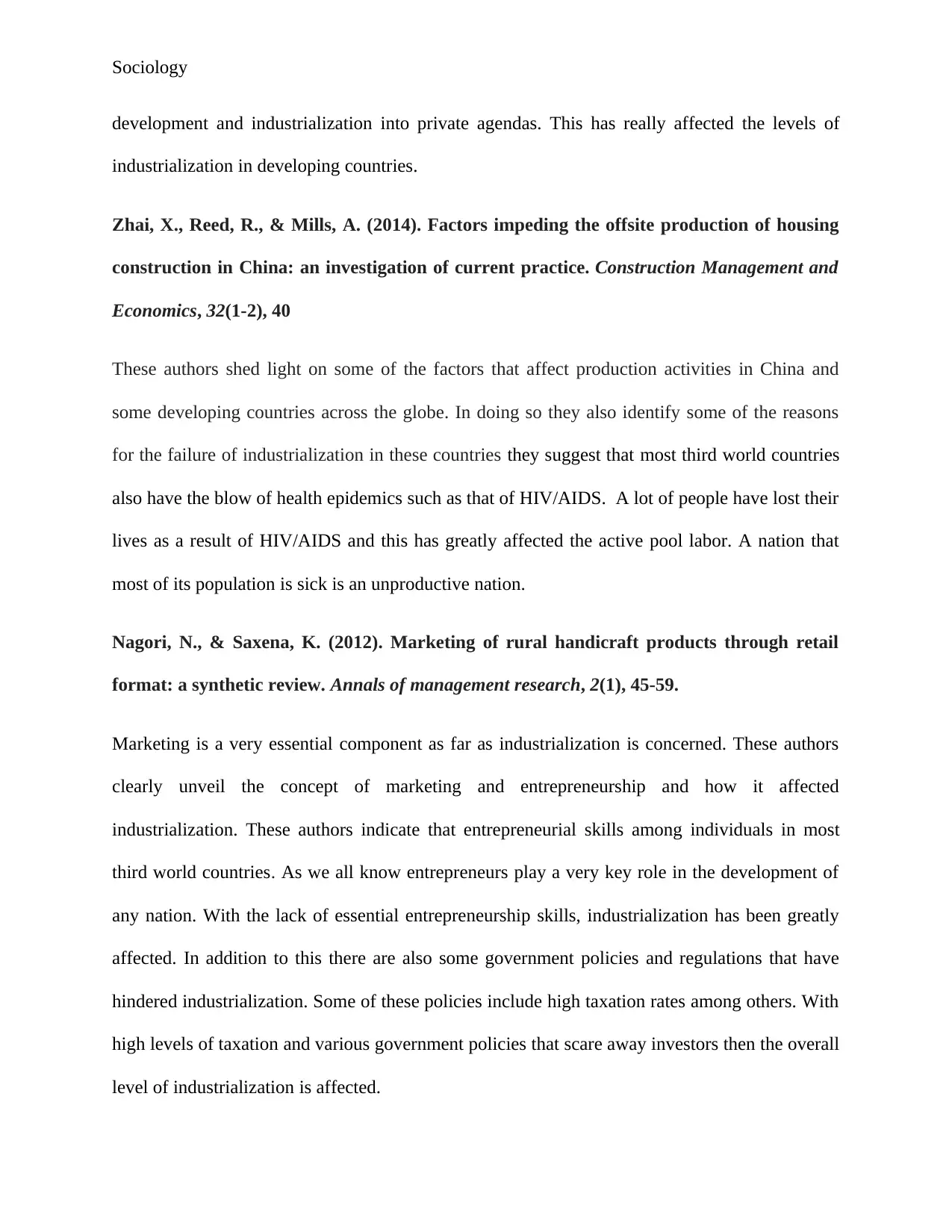
Sociology
development and industrialization into private agendas. This has really affected the levels of
industrialization in developing countries.
Zhai, X., Reed, R., & Mills, A. (2014). Factors impeding the offsite production of housing
construction in China: an investigation of current practice. Construction Management and
Economics, 32(1-2), 40
These authors shed light on some of the factors that affect production activities in China and
some developing countries across the globe. In doing so they also identify some of the reasons
for the failure of industrialization in these countries they suggest that most third world countries
also have the blow of health epidemics such as that of HIV/AIDS. A lot of people have lost their
lives as a result of HIV/AIDS and this has greatly affected the active pool labor. A nation that
most of its population is sick is an unproductive nation.
Nagori, N., & Saxena, K. (2012). Marketing of rural handicraft products through retail
format: a synthetic review. Annals of management research, 2(1), 45-59.
Marketing is a very essential component as far as industrialization is concerned. These authors
clearly unveil the concept of marketing and entrepreneurship and how it affected
industrialization. These authors indicate that entrepreneurial skills among individuals in most
third world countries. As we all know entrepreneurs play a very key role in the development of
any nation. With the lack of essential entrepreneurship skills, industrialization has been greatly
affected. In addition to this there are also some government policies and regulations that have
hindered industrialization. Some of these policies include high taxation rates among others. With
high levels of taxation and various government policies that scare away investors then the overall
level of industrialization is affected.
development and industrialization into private agendas. This has really affected the levels of
industrialization in developing countries.
Zhai, X., Reed, R., & Mills, A. (2014). Factors impeding the offsite production of housing
construction in China: an investigation of current practice. Construction Management and
Economics, 32(1-2), 40
These authors shed light on some of the factors that affect production activities in China and
some developing countries across the globe. In doing so they also identify some of the reasons
for the failure of industrialization in these countries they suggest that most third world countries
also have the blow of health epidemics such as that of HIV/AIDS. A lot of people have lost their
lives as a result of HIV/AIDS and this has greatly affected the active pool labor. A nation that
most of its population is sick is an unproductive nation.
Nagori, N., & Saxena, K. (2012). Marketing of rural handicraft products through retail
format: a synthetic review. Annals of management research, 2(1), 45-59.
Marketing is a very essential component as far as industrialization is concerned. These authors
clearly unveil the concept of marketing and entrepreneurship and how it affected
industrialization. These authors indicate that entrepreneurial skills among individuals in most
third world countries. As we all know entrepreneurs play a very key role in the development of
any nation. With the lack of essential entrepreneurship skills, industrialization has been greatly
affected. In addition to this there are also some government policies and regulations that have
hindered industrialization. Some of these policies include high taxation rates among others. With
high levels of taxation and various government policies that scare away investors then the overall
level of industrialization is affected.
⊘ This is a preview!⊘
Do you want full access?
Subscribe today to unlock all pages.

Trusted by 1+ million students worldwide
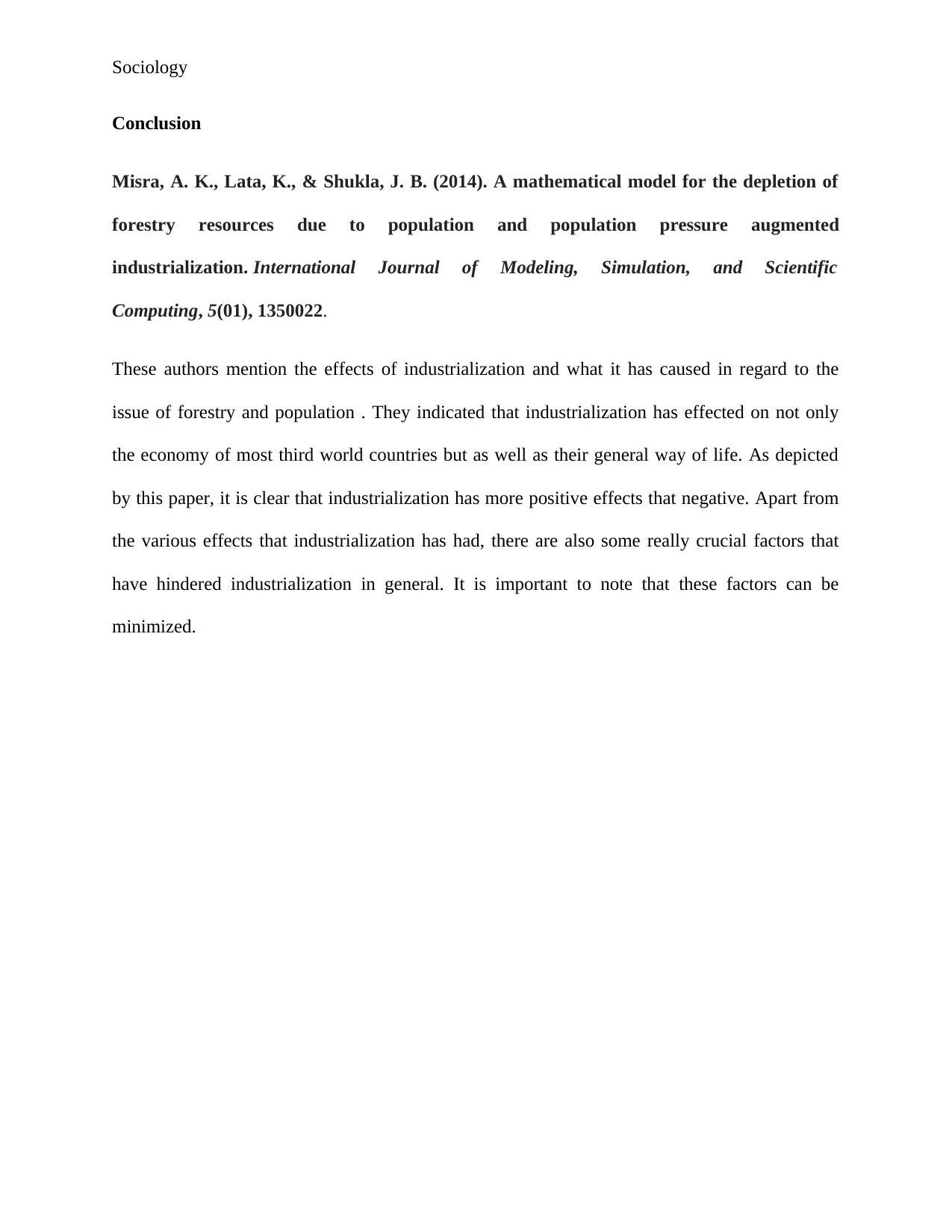
Sociology
Conclusion
Misra, A. K., Lata, K., & Shukla, J. B. (2014). A mathematical model for the depletion of
forestry resources due to population and population pressure augmented
industrialization. International Journal of Modeling, Simulation, and Scientific
Computing, 5(01), 1350022.
These authors mention the effects of industrialization and what it has caused in regard to the
issue of forestry and population . They indicated that industrialization has effected on not only
the economy of most third world countries but as well as their general way of life. As depicted
by this paper, it is clear that industrialization has more positive effects that negative. Apart from
the various effects that industrialization has had, there are also some really crucial factors that
have hindered industrialization in general. It is important to note that these factors can be
minimized.
Conclusion
Misra, A. K., Lata, K., & Shukla, J. B. (2014). A mathematical model for the depletion of
forestry resources due to population and population pressure augmented
industrialization. International Journal of Modeling, Simulation, and Scientific
Computing, 5(01), 1350022.
These authors mention the effects of industrialization and what it has caused in regard to the
issue of forestry and population . They indicated that industrialization has effected on not only
the economy of most third world countries but as well as their general way of life. As depicted
by this paper, it is clear that industrialization has more positive effects that negative. Apart from
the various effects that industrialization has had, there are also some really crucial factors that
have hindered industrialization in general. It is important to note that these factors can be
minimized.
Paraphrase This Document
Need a fresh take? Get an instant paraphrase of this document with our AI Paraphraser
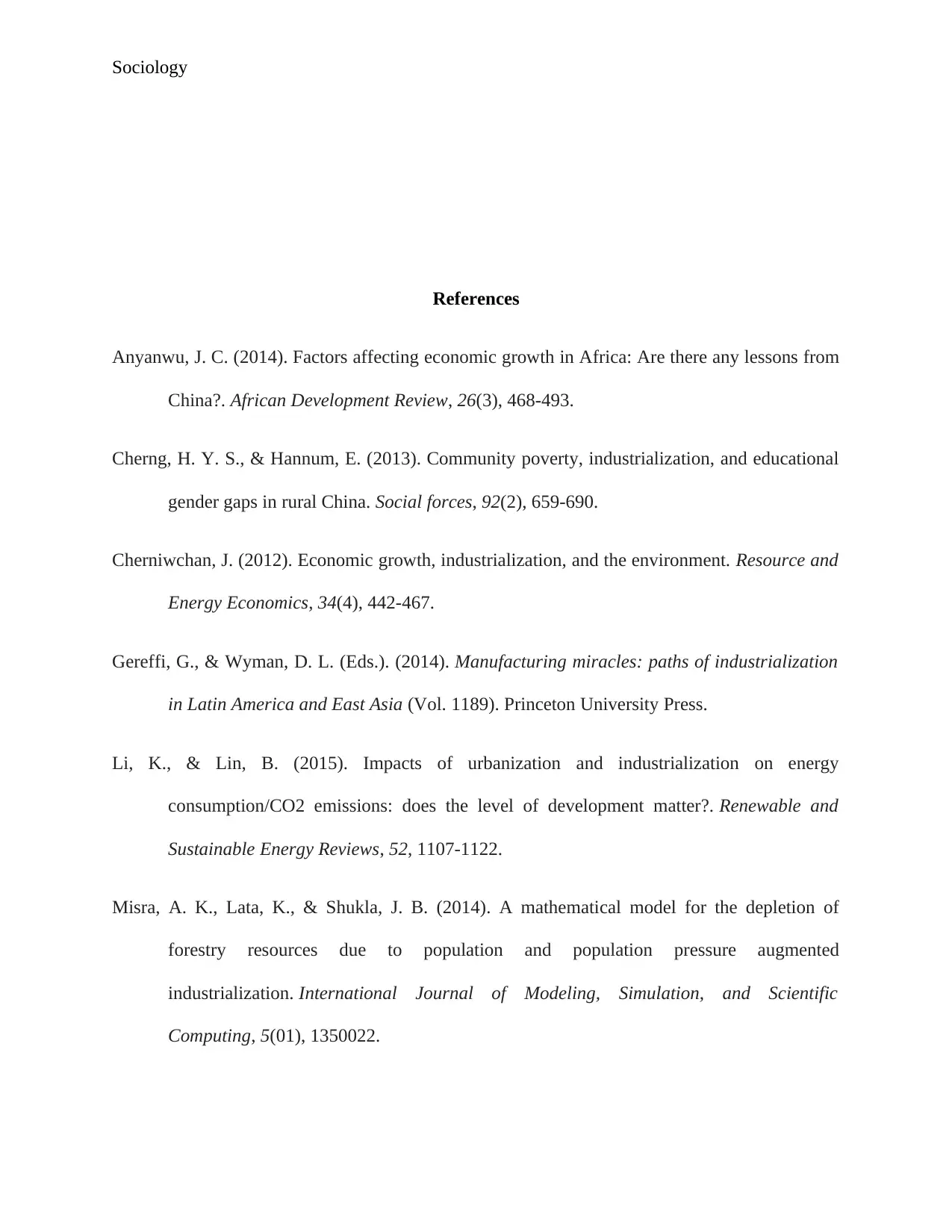
Sociology
References
Anyanwu, J. C. (2014). Factors affecting economic growth in Africa: Are there any lessons from
China?. African Development Review, 26(3), 468-493.
Cherng, H. Y. S., & Hannum, E. (2013). Community poverty, industrialization, and educational
gender gaps in rural China. Social forces, 92(2), 659-690.
Cherniwchan, J. (2012). Economic growth, industrialization, and the environment. Resource and
Energy Economics, 34(4), 442-467.
Gereffi, G., & Wyman, D. L. (Eds.). (2014). Manufacturing miracles: paths of industrialization
in Latin America and East Asia (Vol. 1189). Princeton University Press.
Li, K., & Lin, B. (2015). Impacts of urbanization and industrialization on energy
consumption/CO2 emissions: does the level of development matter?. Renewable and
Sustainable Energy Reviews, 52, 1107-1122.
Misra, A. K., Lata, K., & Shukla, J. B. (2014). A mathematical model for the depletion of
forestry resources due to population and population pressure augmented
industrialization. International Journal of Modeling, Simulation, and Scientific
Computing, 5(01), 1350022.
References
Anyanwu, J. C. (2014). Factors affecting economic growth in Africa: Are there any lessons from
China?. African Development Review, 26(3), 468-493.
Cherng, H. Y. S., & Hannum, E. (2013). Community poverty, industrialization, and educational
gender gaps in rural China. Social forces, 92(2), 659-690.
Cherniwchan, J. (2012). Economic growth, industrialization, and the environment. Resource and
Energy Economics, 34(4), 442-467.
Gereffi, G., & Wyman, D. L. (Eds.). (2014). Manufacturing miracles: paths of industrialization
in Latin America and East Asia (Vol. 1189). Princeton University Press.
Li, K., & Lin, B. (2015). Impacts of urbanization and industrialization on energy
consumption/CO2 emissions: does the level of development matter?. Renewable and
Sustainable Energy Reviews, 52, 1107-1122.
Misra, A. K., Lata, K., & Shukla, J. B. (2014). A mathematical model for the depletion of
forestry resources due to population and population pressure augmented
industrialization. International Journal of Modeling, Simulation, and Scientific
Computing, 5(01), 1350022.
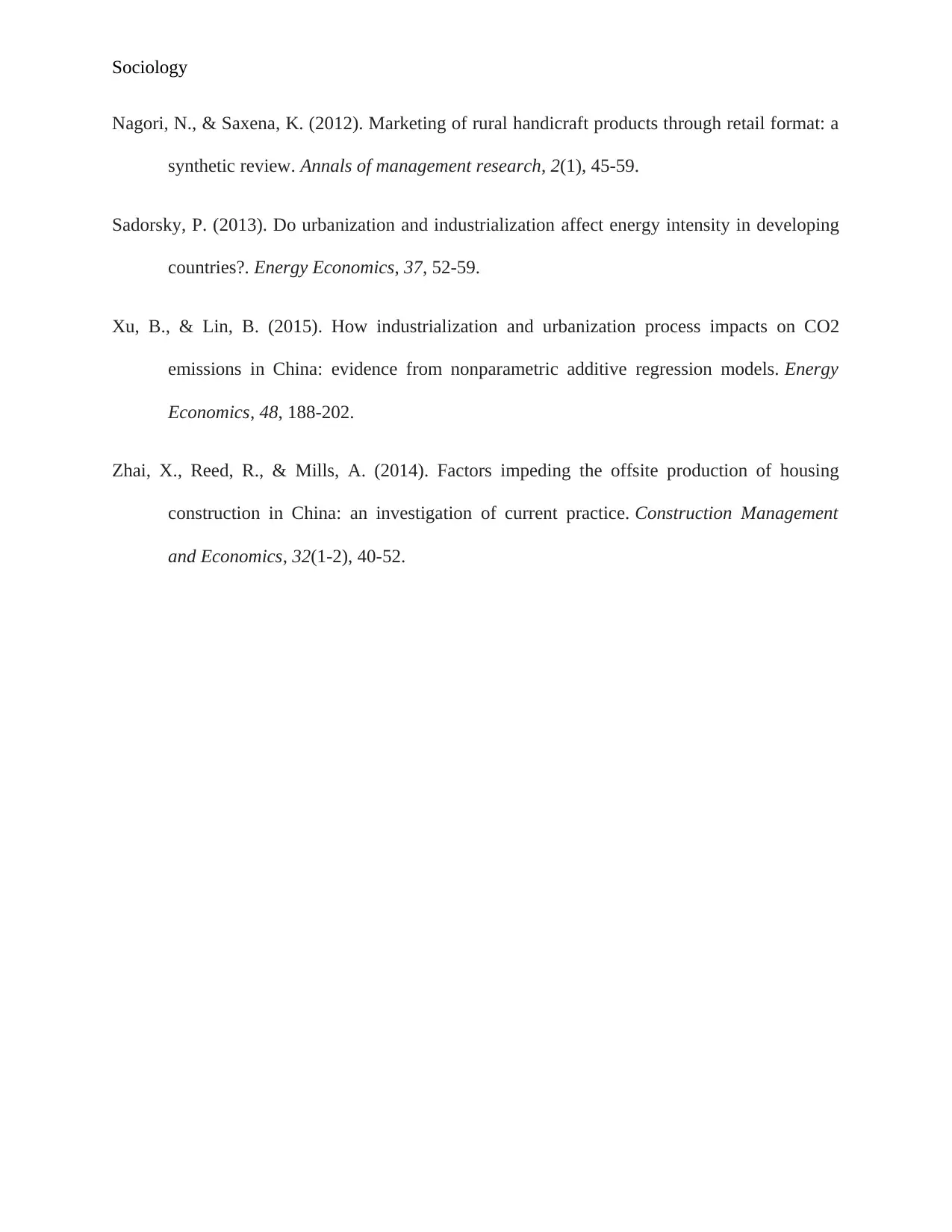
Sociology
Nagori, N., & Saxena, K. (2012). Marketing of rural handicraft products through retail format: a
synthetic review. Annals of management research, 2(1), 45-59.
Sadorsky, P. (2013). Do urbanization and industrialization affect energy intensity in developing
countries?. Energy Economics, 37, 52-59.
Xu, B., & Lin, B. (2015). How industrialization and urbanization process impacts on CO2
emissions in China: evidence from nonparametric additive regression models. Energy
Economics, 48, 188-202.
Zhai, X., Reed, R., & Mills, A. (2014). Factors impeding the offsite production of housing
construction in China: an investigation of current practice. Construction Management
and Economics, 32(1-2), 40-52.
Nagori, N., & Saxena, K. (2012). Marketing of rural handicraft products through retail format: a
synthetic review. Annals of management research, 2(1), 45-59.
Sadorsky, P. (2013). Do urbanization and industrialization affect energy intensity in developing
countries?. Energy Economics, 37, 52-59.
Xu, B., & Lin, B. (2015). How industrialization and urbanization process impacts on CO2
emissions in China: evidence from nonparametric additive regression models. Energy
Economics, 48, 188-202.
Zhai, X., Reed, R., & Mills, A. (2014). Factors impeding the offsite production of housing
construction in China: an investigation of current practice. Construction Management
and Economics, 32(1-2), 40-52.
⊘ This is a preview!⊘
Do you want full access?
Subscribe today to unlock all pages.

Trusted by 1+ million students worldwide
1 out of 9
Your All-in-One AI-Powered Toolkit for Academic Success.
+13062052269
info@desklib.com
Available 24*7 on WhatsApp / Email
![[object Object]](/_next/static/media/star-bottom.7253800d.svg)
Unlock your academic potential
Copyright © 2020–2025 A2Z Services. All Rights Reserved. Developed and managed by ZUCOL.


